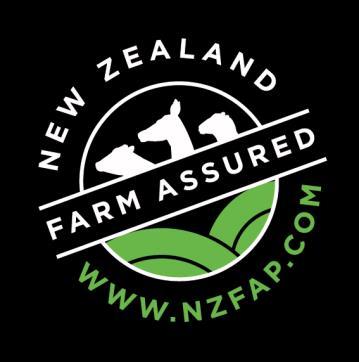
4 minute read
7. Farm to Processor
7.1 Pre-transport
It is important that livestock are held to empty out before being transported. This will help minimise any potential risk of contamination, animal welfare issues and excessive build-up of effluent on trucks.
Requirements
7.1.1 For pre-transport selection and management, the person in charge ofthe animals shall examine the selected livestock prior to transport to ensure that all animals are fit and healthy fortransportation.
7.1.2
7.1.3
7.1.4
7.1.5
7.1.6
7.1.7 Animals shall be able to stand and be able to bear weight evenly on all four limbs and be fit enough to withstand the journey without suffering unreasonable or unnecessary pain or distress. Such animals are not acceptable for transport unless accompanied by a Fitness of Livestock for Transport Veterinary Declaration and the conditions of that declaration shall be met.
Proper care shall be taken when deciding whether it is appropriate to transport young, old, pregnant or otherwise physiologically or behaviourally compromised animals. Cattle shall not be less than body condition score 3.0 (on the dairy cattle 1-10 scale) or 1.5 (on the beef scale) to be acceptable for transport direct to processing. Cattle scoring less than these scores are subject to travel restrictions and must have a Fitness of Livestock for Transport Veterinary Declaration. Animals shall not be transported ifthey are likely to give birth during the journey or within 24 hours of arrival at slaughter premises or sale yards or if they are likely to be affected by metabolic complications of late pregnancy as a result of the journey. Animals shall be at least 14 days old except for bobby calves which must be at least four days old. Cattle with horns ofa length that may cause injury or be damaged (spanning greater than 550mm) shall not be transported.
7.1.8
7.1.9
7.1.10
7.1.11 Animals shall not be transported with an ingrown horn, injured horn/antler, an injured or diseased udder, advanced eye cancer within 21 days ofbeing disbudded, dehorned or within seven days of being castrated or tail docked.
Deer with hard antler growth greater than 110mm measured from the centre ofthe skull between the pedicles must not be presented for transport to slaughter. Pregnant hinds must not be transported after 1 October. All livestock shall have access to clean drinking water for a minimum offourhours prior to loading.
Recommendations
Livestock for sale should be drafted and prepared at least the day before transport
Scales should be used as an aid for drafting livestock
All holding yards and pens should have a base of shingle or other material that avoids excessive dust, mud or contamination of livestock
All livestock should be held off pasture, with water and an appropriate alternative feed source provided for a minimum of four hours (but no more than 12 hours) prior to loading.
7.2 Preparation of Dairy Cows for Transport
Lactating dairycows have a high riskofexperiencing acute metabolic crises associated with the stresses offeed withdrawal, transport and lairage. These risks can be minimised if cows selected for transport to slaughter are adequately prepared prior to transport and travel time from farm to the meat processor or sale yard is as short as possible. Metabolic crises can occur throughout the year and at all stages of lactation with a greater risk of complications occurring during the spring and autumn.
Requirements
7.2.1 Cows that are still lactating must be sufficiently milked out prior to transport so that the udder is not distended when the cow is picked up. Note: this is not usually a problem with cows supplied in autumn.
7.2.2 Cows must be given access to feed after the last milking prior to transport. This is to replenish metabolites (calcium, magnesium) removed by milking. Or supplement cows with magnesium and calcium on the day of transport.
Recommendations
Cows should be adequately dried offbefore transport. Identifying those cows that are to be transported at least one week prior to transport provides the opportunity to dry off these cows. It is acknowledged that it may not always be possible to effectively and completely dry these cows off.
Dairy cattle shall not be less than body condition score 3.0 to be acceptable for transport direct to processing. Cattle scoring less than 3.0 are subject to travel restrictions and must have a veterinarians certificate.
7.3 Livestock Transport
Requirements
7.3.1 The owner of the livestock or an authorised representative shall be present at all times during loading.
7.3.2
7.3.3 There must be all-weather truck access to loading ramps. The following documentation shall be provided to the driver:
Fully completed and signed Animal Status Declaration (ASD) (eASD may be sent directly to processor) with correct tallies, descriptions and time of loading
Fitness of Livestock for Transport Veterinary Declaration for any livestock where there is doubt about fitness for transport and slaughter.
7.3.4 Farmers have the right to refuse to load livestock where they consider the crate is unclean or unsafe.
7.4 Farmer/Owner –Livestock Transport
All farmers/owners with livestock crates who have the intention of transporting their own stock to a slaughter processor must be adequately trained in the Transport within New Zealand Code of Welfare. Driver Training and livestock crate standards will be randomly checked at the processing sites. Animal Welfare (Transport within New Zealand) Code of Welfare
Requirements
7.4.1 The livestock crate must meet the above code of welfare and be available for inspection during the farm audit.
7.4.2 Driver training –meet company livestock transportation standards.




